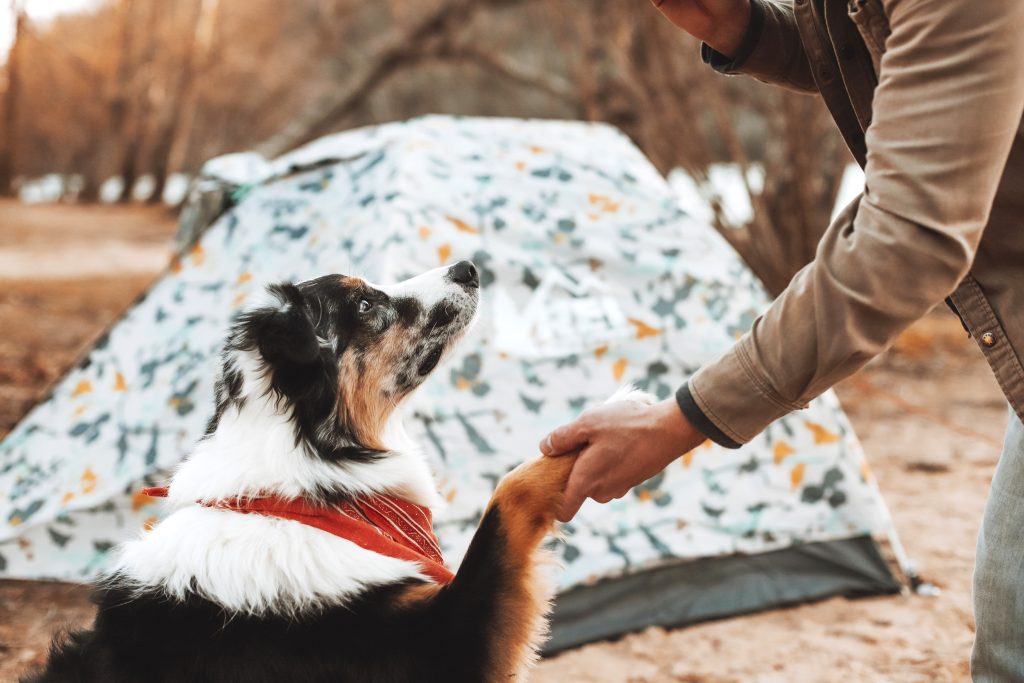
You’ve just hit the jackpot! Your Australian Shepherd, the Einstein of the dog world, is ready to charm you with its smarts. But are you ready for the challenge? Fear not, this guide has got you covered. You’ll delve into the art of training your Aussie, from basic cues to advanced techniques. Prepare for an exciting journey that will turn your furball into a well-trained, loyal companion. Let’s embark on this adventure together!
Understanding Your Australian Shepherd
To effectively train your Aussie, you’ll first need to understand their unique qualities and instincts. Known for their intelligence and high energy, the Australian Shepherd is a breed that thrives on having a job to do. This makes the Australian Shepherd training process a bit different from training other breeds.
The Australian Shepherd temperament is often described as lively, agile, and slightly mischievous. They’re bred to be working dogs, which means they have a natural instinct to herd. This can make them a bit nippy at times but don’t worry, with consistent training this behavior can be curbed.
Understanding your Australian Shepherd also means recognizing their need for mental stimulation. Without it, they can become bored and destructive. Incorporate tasks and games into your training routine to keep them engaged.
Establishing Training Basics
So, how do you establish the training basics with your Australian Shepherd? Well, training an Australian Shepherd, just like any other dog, starts with building a strong foundation. It’s essential to start australian shepherd puppy training as early as possible.
First, start with basic commands such as ‘sit’, ‘stay’, and ‘come’. Consistency is key in training Australian Shepherds, so make sure to use the same command words and reward your pup each time they obey. This will help them associate the action with a positive outcome.
Next, you should also start leash training. A well-behaved Australian Shepherd should walk nicely on a leash without pulling. This requires patience and consistency, but is an essential part of training a Australian Shepherd.
Socialization is another basic you need to establish. Expose your Aussie to different people, animals, and environments to help them become more adaptable and less fearful.
Lastly, even if you’re training a mini Australian Shepherd, crate training should be part of the basics. A crate can be a safe haven for your dog and is a useful tool for house training.
Socializing Your Aussie Pup

Moving on to socializing your Aussie pup, it’s crucial you start introducing them to new people, places, and situations from a young age. Australian Shepherd training can be a fulfilling endeavor, especially when you see results in your puppy’s behavior.
Training an Australian Shepherd puppy requires a lot of patience and consistency, but when it comes to socializing your Aussie pup, it’s all about exposure and positive reinforcement. Introduce your Australian Shepherd puppy to different environments, sounds, and people. This exposure will help them grow into a confident and well-behaved dog.
Don’t forget about the importance of play dates. Let your pup interact with other vaccinated pups. This will help them learn how to behave around other dogs. It’s also a great opportunity for them to burn off some puppy energy.
Lastly, remember to keep all these new experiences positive. If your pup seems scared, don’t force them into anything. Instead, gradually ease them into the situation. Remember, training Australian Shepherd puppies isn’t just about teaching commands, it’s about raising a well-rounded dog.
Mastering House Training
The moment you bring your Aussie home, you should begin house training to establish clear expectations and routines. This crucial stage of Australian Shepherd training will lay the foundation for your puppy’s behaviour in your home. Remember, consistency is the key to success.
Whether you are training a full-sized Australian Shepherd or going through mini Australian Shepherd training, the process remains relatively the same. Here are a few key points to guide you:
– Establish a routine: Dogs thrive on predictability. Feed your Aussie at the same time each day and take them out regularly for potty breaks.
– Reward success: When they do their business outside, shower them with praise. This positive reinforcement will motivate them to repeat the behaviour.
– Be patient: Accidents will happen. It’s part of the process. Instead of punishing, clean up and continue with the routine.
Understanding the mini Australian Shepherd temperament or that of a standard Aussie, you’ll find they are eager to please and quick to learn. With patience and consistency, you’ll effectively master house training.
Now that your Aussie is comfortable at home, it’s time to move on to teaching basic commands.
Teaching Basic Commands

Why shouldn’t you start teaching your Aussie basic commands like ‘sit’, ‘stay’, and ‘come’ right away? Well, there’s no reason you shouldn’t. Training your Australian Shepherd puppies, whether they’re a mini Australian shepherd or a full-sized one, should start as soon as possible. These intelligent dogs are eager to learn, and their Australian Shepherd dog temperament makes them excellent learners.
Begin with simple commands. For instance, teaching ‘sit’ is a great starting point. Use a treat to guide your Aussie’s bottom to the ground, then say ‘sit’. When they comply, immediately reward them. Remember to keep training sessions short, fun, and positive.
The ‘stay’ command is vital for safety. Start by asking your Aussie to ‘sit’. Then, holding your palm out towards them, say ‘stay’. Take a few steps back. If they remain in place, reward them. Gradually increase the distance.
Addressing Behavioral Issues
After mastering basic commands, you might find a few behavioral issues cropping up with your Aussie that need addressing. The affenpinscher, while a different breed, shares some of the same behavioral challenges. By learning from their training strategies, it can be possible to address and rectify the issues effectively.
Behavioral issues can stem from various sources such as boredom, lack of exercise, or even anxiety. But fear not, resolving these is not as daunting as it may seem. You can follow these simple steps:
– Identify the cause: Understanding what triggers your Aussie’s behaviour can be a big step towards addressing it.
– Positive reinforcement: Reward your Aussie for good behaviour. Contrarily, ignore or redirect them during unwanted actions.
– Consistency is key: Just like with the affenpinscher, consistent training ensures your Aussie understands what is expected of them.
Leash Training Your Aussie

Before you can enjoy leisurely walks with your Aussie, it’s essential that you focus on leash training to ensure they’re well-behaved and safe. Leash training isn’t about control, but about teaching your dog to respect boundaries and to be comfortable with the leash.
Start indoors, in a familiar environment, and let your Aussie wear the leash around the house. This allows them to get accustomed to the feel of it. Reward your dog for staying calm and relaxed while wearing the leash.
Next, begin teaching the ‘heel’ command. When your Aussie walks beside you without pulling, reward them with treats or praise. If they pull, stop walking until they return to your side. Remember, consistency is key in any training routine.
Gradually introduce distractions, such as other people or dogs, while continuing your leash training. This will help your Aussie to stay focused on you, even in stimulating environments.
The Importance of Mental Stimulation
In addition to physical exercise, it’s crucial for your Aussie’s well-being to receive plenty of mental stimulation. Stimulating your Aussie’s brain helps prevent boredom and undesirable behaviors stemming from inactivity. As Aussies are an intelligent breed, they thrive when they can use their brains.
There are various ways to mentally stimulate your Aussie. Let’s look at a few:
* **Interactive Toys:** These toys require your Aussie to think and problem solve. This not only keeps them entertained but also helps develop cognitive skills.
* **Training Sessions:** Regular training sessions where you teach new tricks or commands provide mental exercise. This also strengthens the bond between you and your Aussie, making training a joyful experience.
* **Dog Puzzles:** These require your Aussie to figure out how to get a treat or toy out of the puzzle, keeping their mind active.
Advanced Training Techniques

Once you’ve nailed down the basics, you can start delving into advanced training techniques with your Australian Shepherd. Advanced training not only sharpens your Aussie’s skills, but also provides the mental stimulation they need.
One of the techniques you can use is agility training. It’s a fantastic way to channel your Aussie’s boundless energy and intelligence. Set up an obstacle course in your backyard and train your dog to navigate through it. This will not only improve their physical fitness but also boost their confidence and responsiveness to commands.
Another advanced technique is teaching your Aussie to perform tricks. This can range from fetching items, rolling over, to even more complex tasks like sorting toys by color. Remember to always use positive reinforcement and give rewards for each successful task.
Finally, consider enrolling your Aussie in dog sports like herding, obedience, or flyball. This not only provides a great bonding experience but also helps your dog to socialize with others.
Consistency in Training Routines
As you progress from basic to advanced training with your Aussie, maintaining a consistent routine is paramount in reinforcing and building on previously learned behaviors. Consistency helps your dog understand what’s expected of them, making training more effective and less confusing.
Remember, dogs thrive on routine. They like knowing when it’s time to eat, play, and sleep. If you’re consistent, your Aussie will quickly pick up on these routines and their behavior will reflect this understanding.
Consistency isn’t just about the routine, though. It’s also about reinforcing the rules and expectations you’ve set for your dog. If you let your Aussie get away with breaking the rules sometimes, they’ll start to think it’s acceptable behavior.
* Don’t let those puppy dog eyes sway you. Be firm, but loving.
* Remember, every interaction is a learning opportunity.
* Be patient. Training doesn’t happen overnight.
In the end, consistency in training routines will lead to a well-behaved, happy, and secure Australian Shepherd. They will know what’s expected of them and will be eager to please you. And isn’t that what every dog owner wants? A loyal, well-behaved companion who’s a joy to be around.
Conclusion
Training your Aussie can be a rewarding journey. With their intelligence, they can master many commands – in fact, they can understand new ones after only five repetitions 95% of the time. Keep in mind, consistency is key. Engage their mind and body with stimulating activities, and always remember to reward positive behavior. With patience and dedication, you’ll have a well-trained Australian Shepherd who’s not only a pet, but a loyal companion. Happy training!
